Report on Challenges in Managing Global Teams: Analysis
VerifiedAdded on 2021/05/31
|16
|3913
|72
Report
AI Summary
This report examines the challenges faced in managing global teams, a crucial topic in today's multinational business environment. It begins with an introduction highlighting the increasing use of global teams and their potential benefits, such as access to diverse talent and improved organizational performance. The project objective is to improve organizational efficiency through effective global team building. The scope of the project focuses on analyzing challenges faced by members from different countries and cultures. The report identifies common barriers, including communication, language, trust, and cultural differences. It also explores Hofstede's five dimensions of national culture. The literature review provides background information, discusses the advantages of global teams, and examines the causes of failure and techniques for developing international teams. The report outlines research questions, research design, methodology, and limitations. A time schedule is included, and the report concludes with a summary of key findings and recommendations. The report is a valuable resource for understanding and addressing the complexities of global team management.
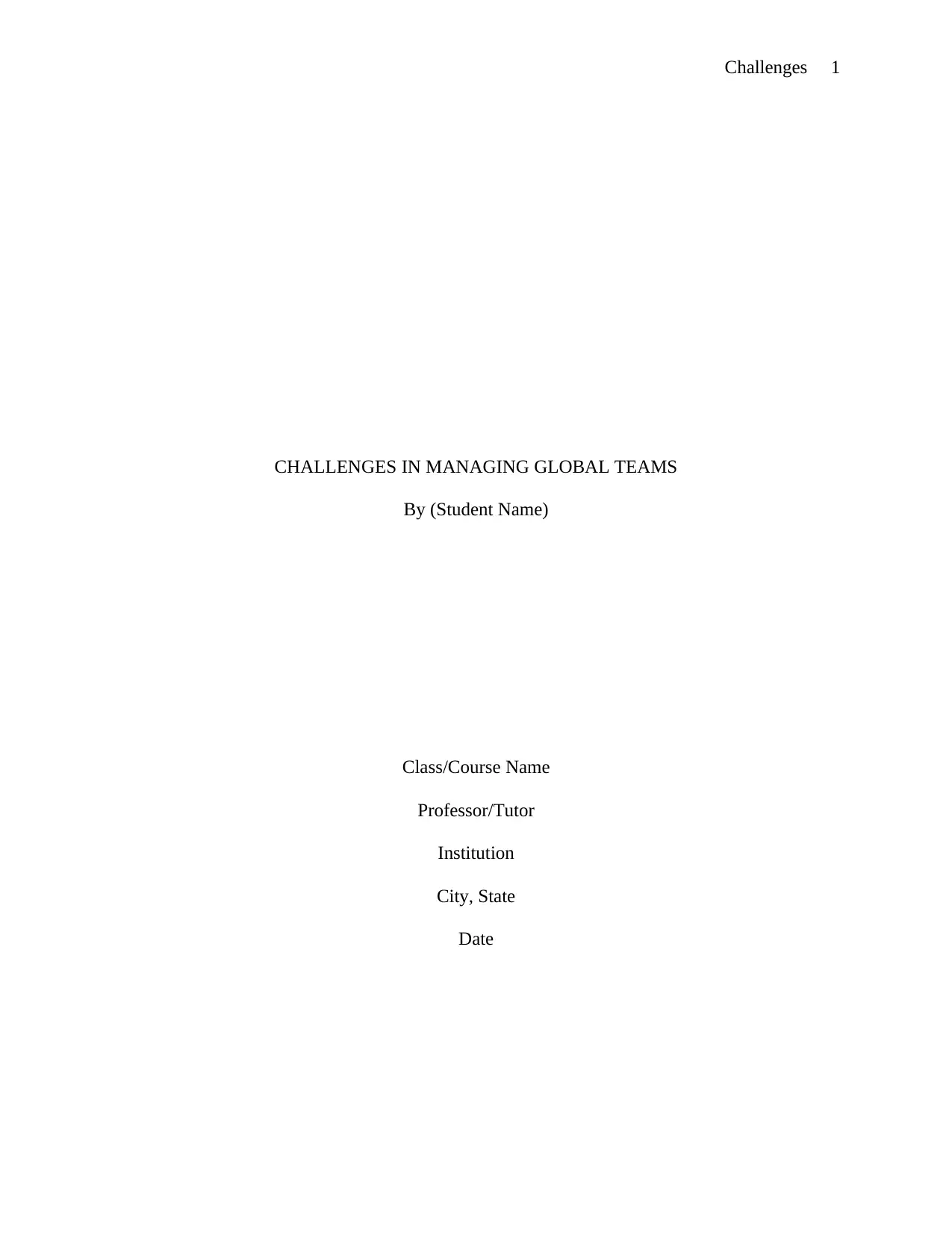
Challenges 1
CHALLENGES IN MANAGING GLOBAL TEAMS
By (Student Name)
Class/Course Name
Professor/Tutor
Institution
City, State
Date
CHALLENGES IN MANAGING GLOBAL TEAMS
By (Student Name)
Class/Course Name
Professor/Tutor
Institution
City, State
Date
Paraphrase This Document
Need a fresh take? Get an instant paraphrase of this document with our AI Paraphraser
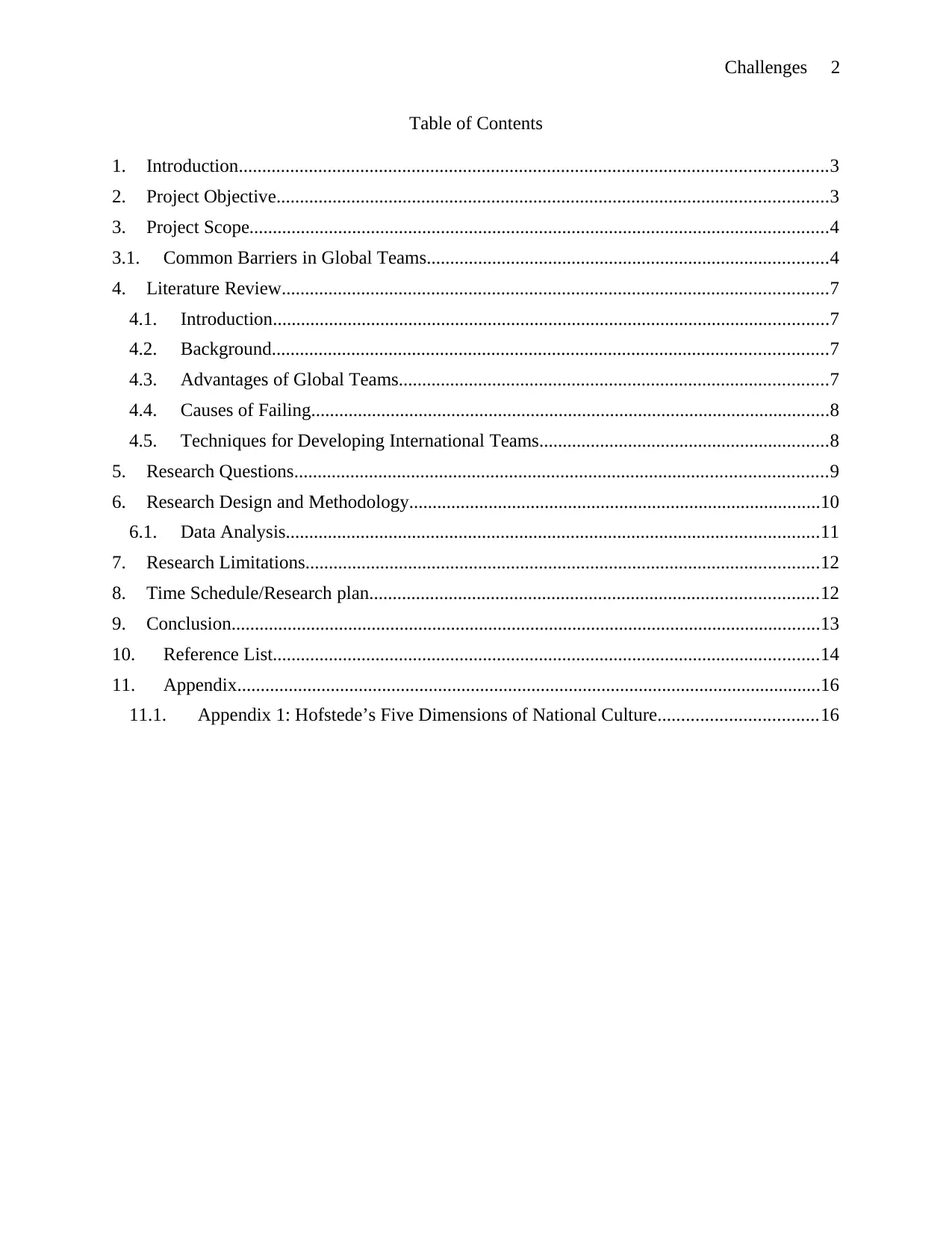
Challenges 2
Table of Contents
1. Introduction..............................................................................................................................3
2. Project Objective......................................................................................................................3
3. Project Scope............................................................................................................................4
3.1. Common Barriers in Global Teams......................................................................................4
4. Literature Review.....................................................................................................................7
4.1. Introduction.......................................................................................................................7
4.2. Background.......................................................................................................................7
4.3. Advantages of Global Teams............................................................................................7
4.4. Causes of Failing...............................................................................................................8
4.5. Techniques for Developing International Teams..............................................................8
5. Research Questions..................................................................................................................9
6. Research Design and Methodology........................................................................................10
6.1. Data Analysis..................................................................................................................11
7. Research Limitations..............................................................................................................12
8. Time Schedule/Research plan................................................................................................12
9. Conclusion..............................................................................................................................13
10. Reference List.....................................................................................................................14
11. Appendix.............................................................................................................................16
11.1. Appendix 1: Hofstede’s Five Dimensions of National Culture..................................16
Table of Contents
1. Introduction..............................................................................................................................3
2. Project Objective......................................................................................................................3
3. Project Scope............................................................................................................................4
3.1. Common Barriers in Global Teams......................................................................................4
4. Literature Review.....................................................................................................................7
4.1. Introduction.......................................................................................................................7
4.2. Background.......................................................................................................................7
4.3. Advantages of Global Teams............................................................................................7
4.4. Causes of Failing...............................................................................................................8
4.5. Techniques for Developing International Teams..............................................................8
5. Research Questions..................................................................................................................9
6. Research Design and Methodology........................................................................................10
6.1. Data Analysis..................................................................................................................11
7. Research Limitations..............................................................................................................12
8. Time Schedule/Research plan................................................................................................12
9. Conclusion..............................................................................................................................13
10. Reference List.....................................................................................................................14
11. Appendix.............................................................................................................................16
11.1. Appendix 1: Hofstede’s Five Dimensions of National Culture..................................16
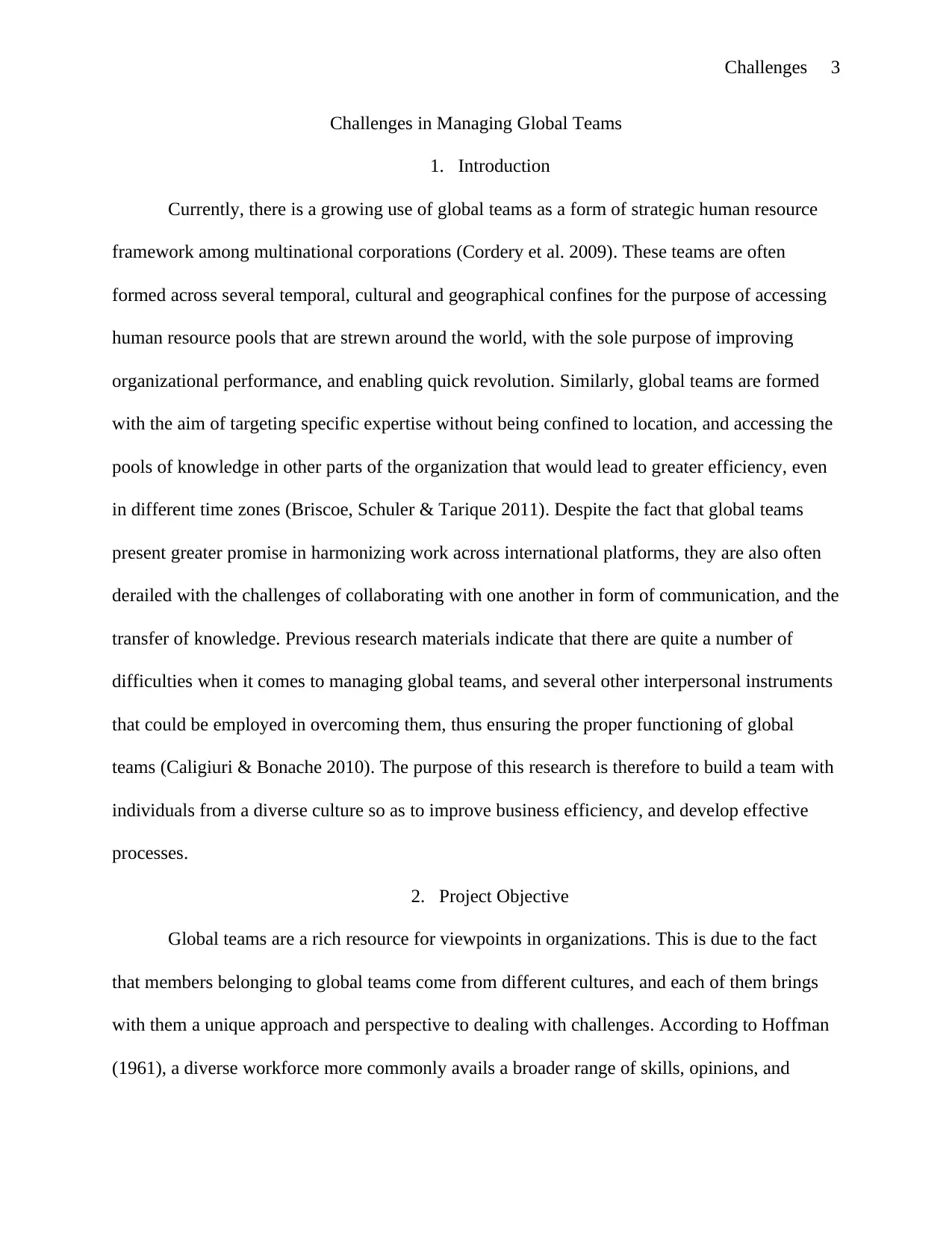
Challenges 3
Challenges in Managing Global Teams
1. Introduction
Currently, there is a growing use of global teams as a form of strategic human resource
framework among multinational corporations (Cordery et al. 2009). These teams are often
formed across several temporal, cultural and geographical confines for the purpose of accessing
human resource pools that are strewn around the world, with the sole purpose of improving
organizational performance, and enabling quick revolution. Similarly, global teams are formed
with the aim of targeting specific expertise without being confined to location, and accessing the
pools of knowledge in other parts of the organization that would lead to greater efficiency, even
in different time zones (Briscoe, Schuler & Tarique 2011). Despite the fact that global teams
present greater promise in harmonizing work across international platforms, they are also often
derailed with the challenges of collaborating with one another in form of communication, and the
transfer of knowledge. Previous research materials indicate that there are quite a number of
difficulties when it comes to managing global teams, and several other interpersonal instruments
that could be employed in overcoming them, thus ensuring the proper functioning of global
teams (Caligiuri & Bonache 2010). The purpose of this research is therefore to build a team with
individuals from a diverse culture so as to improve business efficiency, and develop effective
processes.
2. Project Objective
Global teams are a rich resource for viewpoints in organizations. This is due to the fact
that members belonging to global teams come from different cultures, and each of them brings
with them a unique approach and perspective to dealing with challenges. According to Hoffman
(1961), a diverse workforce more commonly avails a broader range of skills, opinions, and
Challenges in Managing Global Teams
1. Introduction
Currently, there is a growing use of global teams as a form of strategic human resource
framework among multinational corporations (Cordery et al. 2009). These teams are often
formed across several temporal, cultural and geographical confines for the purpose of accessing
human resource pools that are strewn around the world, with the sole purpose of improving
organizational performance, and enabling quick revolution. Similarly, global teams are formed
with the aim of targeting specific expertise without being confined to location, and accessing the
pools of knowledge in other parts of the organization that would lead to greater efficiency, even
in different time zones (Briscoe, Schuler & Tarique 2011). Despite the fact that global teams
present greater promise in harmonizing work across international platforms, they are also often
derailed with the challenges of collaborating with one another in form of communication, and the
transfer of knowledge. Previous research materials indicate that there are quite a number of
difficulties when it comes to managing global teams, and several other interpersonal instruments
that could be employed in overcoming them, thus ensuring the proper functioning of global
teams (Caligiuri & Bonache 2010). The purpose of this research is therefore to build a team with
individuals from a diverse culture so as to improve business efficiency, and develop effective
processes.
2. Project Objective
Global teams are a rich resource for viewpoints in organizations. This is due to the fact
that members belonging to global teams come from different cultures, and each of them brings
with them a unique approach and perspective to dealing with challenges. According to Hoffman
(1961), a diverse workforce more commonly avails a broader range of skills, opinions, and
⊘ This is a preview!⊘
Do you want full access?
Subscribe today to unlock all pages.

Trusted by 1+ million students worldwide
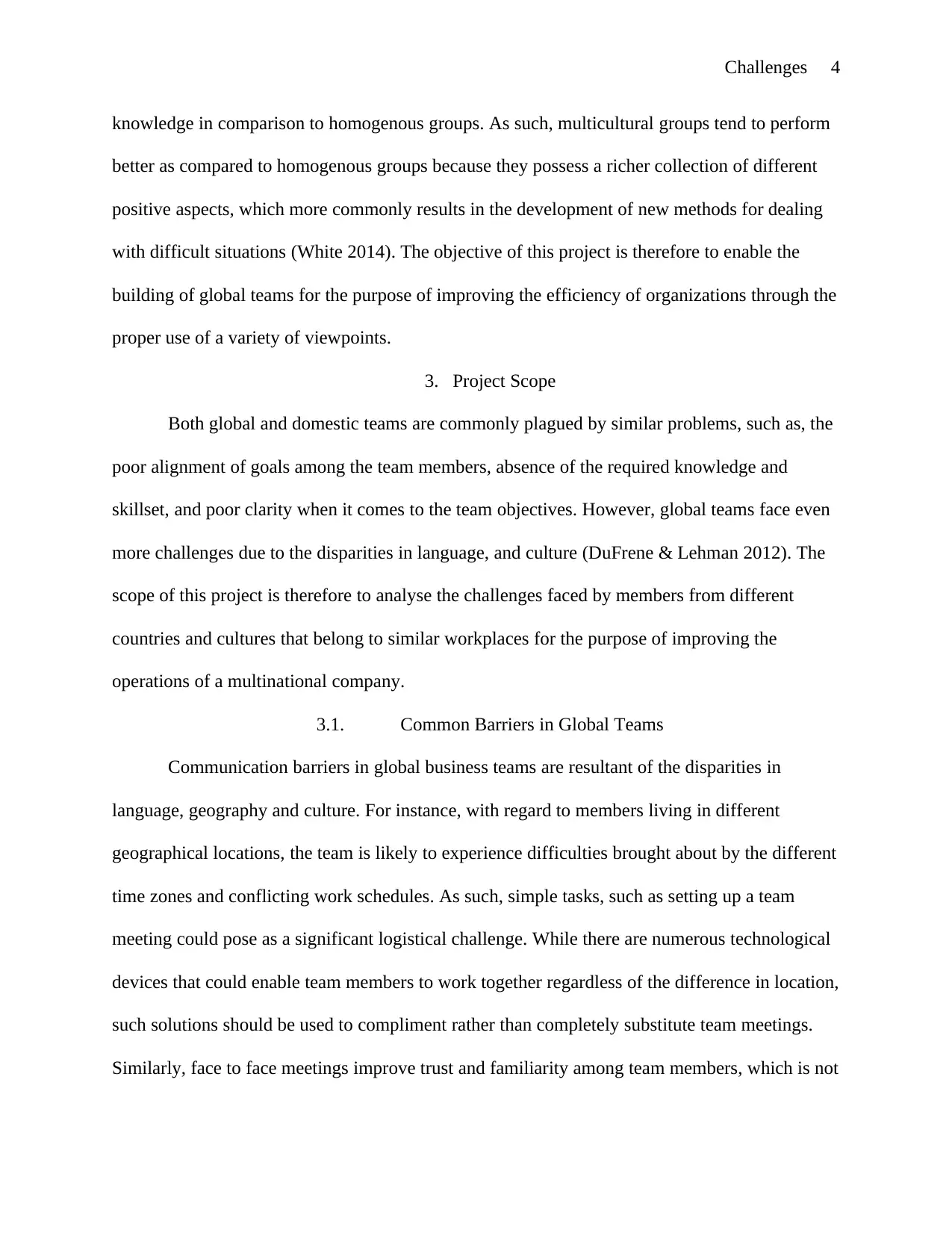
Challenges 4
knowledge in comparison to homogenous groups. As such, multicultural groups tend to perform
better as compared to homogenous groups because they possess a richer collection of different
positive aspects, which more commonly results in the development of new methods for dealing
with difficult situations (White 2014). The objective of this project is therefore to enable the
building of global teams for the purpose of improving the efficiency of organizations through the
proper use of a variety of viewpoints.
3. Project Scope
Both global and domestic teams are commonly plagued by similar problems, such as, the
poor alignment of goals among the team members, absence of the required knowledge and
skillset, and poor clarity when it comes to the team objectives. However, global teams face even
more challenges due to the disparities in language, and culture (DuFrene & Lehman 2012). The
scope of this project is therefore to analyse the challenges faced by members from different
countries and cultures that belong to similar workplaces for the purpose of improving the
operations of a multinational company.
3.1. Common Barriers in Global Teams
Communication barriers in global business teams are resultant of the disparities in
language, geography and culture. For instance, with regard to members living in different
geographical locations, the team is likely to experience difficulties brought about by the different
time zones and conflicting work schedules. As such, simple tasks, such as setting up a team
meeting could pose as a significant logistical challenge. While there are numerous technological
devices that could enable team members to work together regardless of the difference in location,
such solutions should be used to compliment rather than completely substitute team meetings.
Similarly, face to face meetings improve trust and familiarity among team members, which is not
knowledge in comparison to homogenous groups. As such, multicultural groups tend to perform
better as compared to homogenous groups because they possess a richer collection of different
positive aspects, which more commonly results in the development of new methods for dealing
with difficult situations (White 2014). The objective of this project is therefore to enable the
building of global teams for the purpose of improving the efficiency of organizations through the
proper use of a variety of viewpoints.
3. Project Scope
Both global and domestic teams are commonly plagued by similar problems, such as, the
poor alignment of goals among the team members, absence of the required knowledge and
skillset, and poor clarity when it comes to the team objectives. However, global teams face even
more challenges due to the disparities in language, and culture (DuFrene & Lehman 2012). The
scope of this project is therefore to analyse the challenges faced by members from different
countries and cultures that belong to similar workplaces for the purpose of improving the
operations of a multinational company.
3.1. Common Barriers in Global Teams
Communication barriers in global business teams are resultant of the disparities in
language, geography and culture. For instance, with regard to members living in different
geographical locations, the team is likely to experience difficulties brought about by the different
time zones and conflicting work schedules. As such, simple tasks, such as setting up a team
meeting could pose as a significant logistical challenge. While there are numerous technological
devices that could enable team members to work together regardless of the difference in location,
such solutions should be used to compliment rather than completely substitute team meetings.
Similarly, face to face meetings improve trust and familiarity among team members, which is not
Paraphrase This Document
Need a fresh take? Get an instant paraphrase of this document with our AI Paraphraser
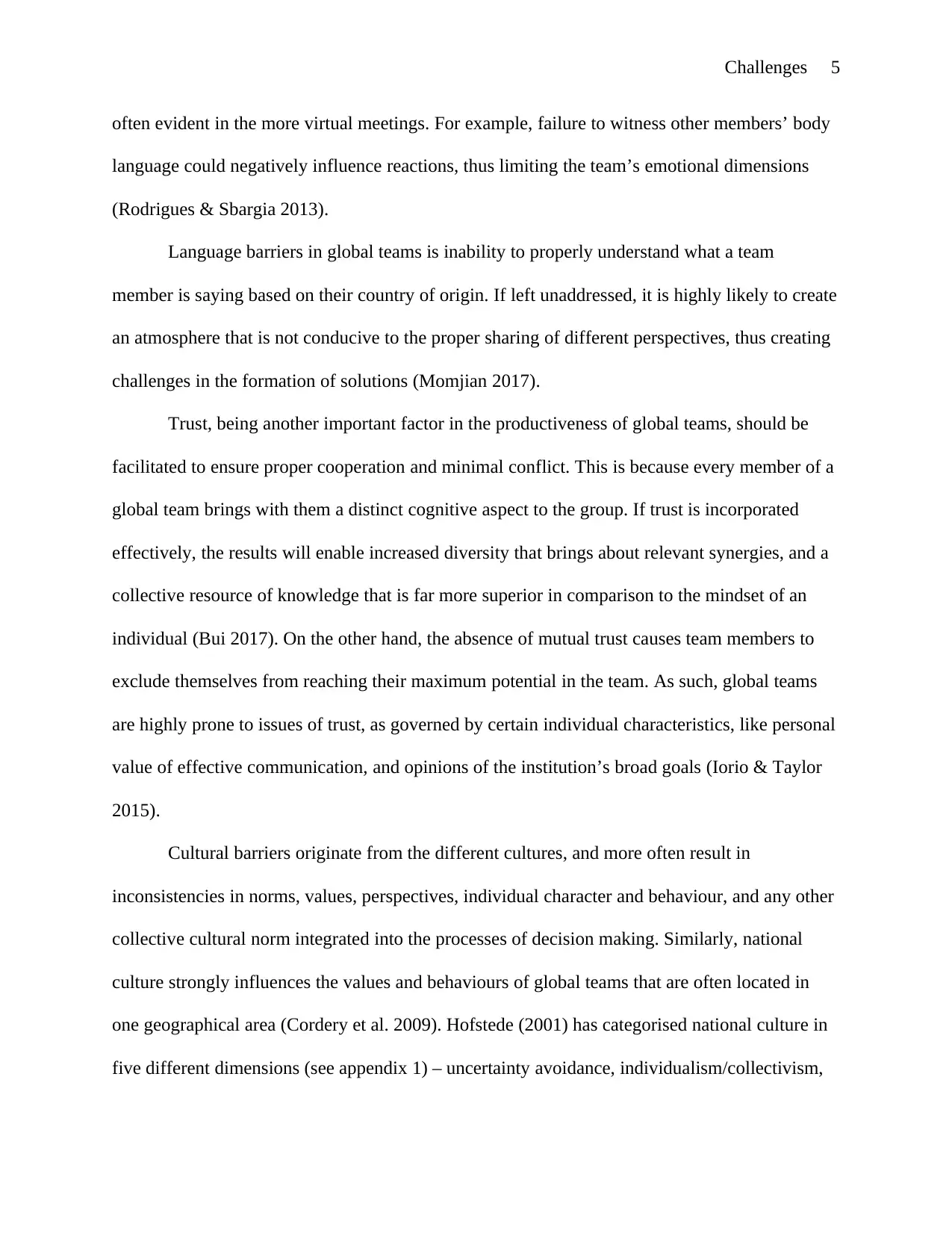
Challenges 5
often evident in the more virtual meetings. For example, failure to witness other members’ body
language could negatively influence reactions, thus limiting the team’s emotional dimensions
(Rodrigues & Sbargia 2013).
Language barriers in global teams is inability to properly understand what a team
member is saying based on their country of origin. If left unaddressed, it is highly likely to create
an atmosphere that is not conducive to the proper sharing of different perspectives, thus creating
challenges in the formation of solutions (Momjian 2017).
Trust, being another important factor in the productiveness of global teams, should be
facilitated to ensure proper cooperation and minimal conflict. This is because every member of a
global team brings with them a distinct cognitive aspect to the group. If trust is incorporated
effectively, the results will enable increased diversity that brings about relevant synergies, and a
collective resource of knowledge that is far more superior in comparison to the mindset of an
individual (Bui 2017). On the other hand, the absence of mutual trust causes team members to
exclude themselves from reaching their maximum potential in the team. As such, global teams
are highly prone to issues of trust, as governed by certain individual characteristics, like personal
value of effective communication, and opinions of the institution’s broad goals (Iorio & Taylor
2015).
Cultural barriers originate from the different cultures, and more often result in
inconsistencies in norms, values, perspectives, individual character and behaviour, and any other
collective cultural norm integrated into the processes of decision making. Similarly, national
culture strongly influences the values and behaviours of global teams that are often located in
one geographical area (Cordery et al. 2009). Hofstede (2001) has categorised national culture in
five different dimensions (see appendix 1) – uncertainty avoidance, individualism/collectivism,
often evident in the more virtual meetings. For example, failure to witness other members’ body
language could negatively influence reactions, thus limiting the team’s emotional dimensions
(Rodrigues & Sbargia 2013).
Language barriers in global teams is inability to properly understand what a team
member is saying based on their country of origin. If left unaddressed, it is highly likely to create
an atmosphere that is not conducive to the proper sharing of different perspectives, thus creating
challenges in the formation of solutions (Momjian 2017).
Trust, being another important factor in the productiveness of global teams, should be
facilitated to ensure proper cooperation and minimal conflict. This is because every member of a
global team brings with them a distinct cognitive aspect to the group. If trust is incorporated
effectively, the results will enable increased diversity that brings about relevant synergies, and a
collective resource of knowledge that is far more superior in comparison to the mindset of an
individual (Bui 2017). On the other hand, the absence of mutual trust causes team members to
exclude themselves from reaching their maximum potential in the team. As such, global teams
are highly prone to issues of trust, as governed by certain individual characteristics, like personal
value of effective communication, and opinions of the institution’s broad goals (Iorio & Taylor
2015).
Cultural barriers originate from the different cultures, and more often result in
inconsistencies in norms, values, perspectives, individual character and behaviour, and any other
collective cultural norm integrated into the processes of decision making. Similarly, national
culture strongly influences the values and behaviours of global teams that are often located in
one geographical area (Cordery et al. 2009). Hofstede (2001) has categorised national culture in
five different dimensions (see appendix 1) – uncertainty avoidance, individualism/collectivism,
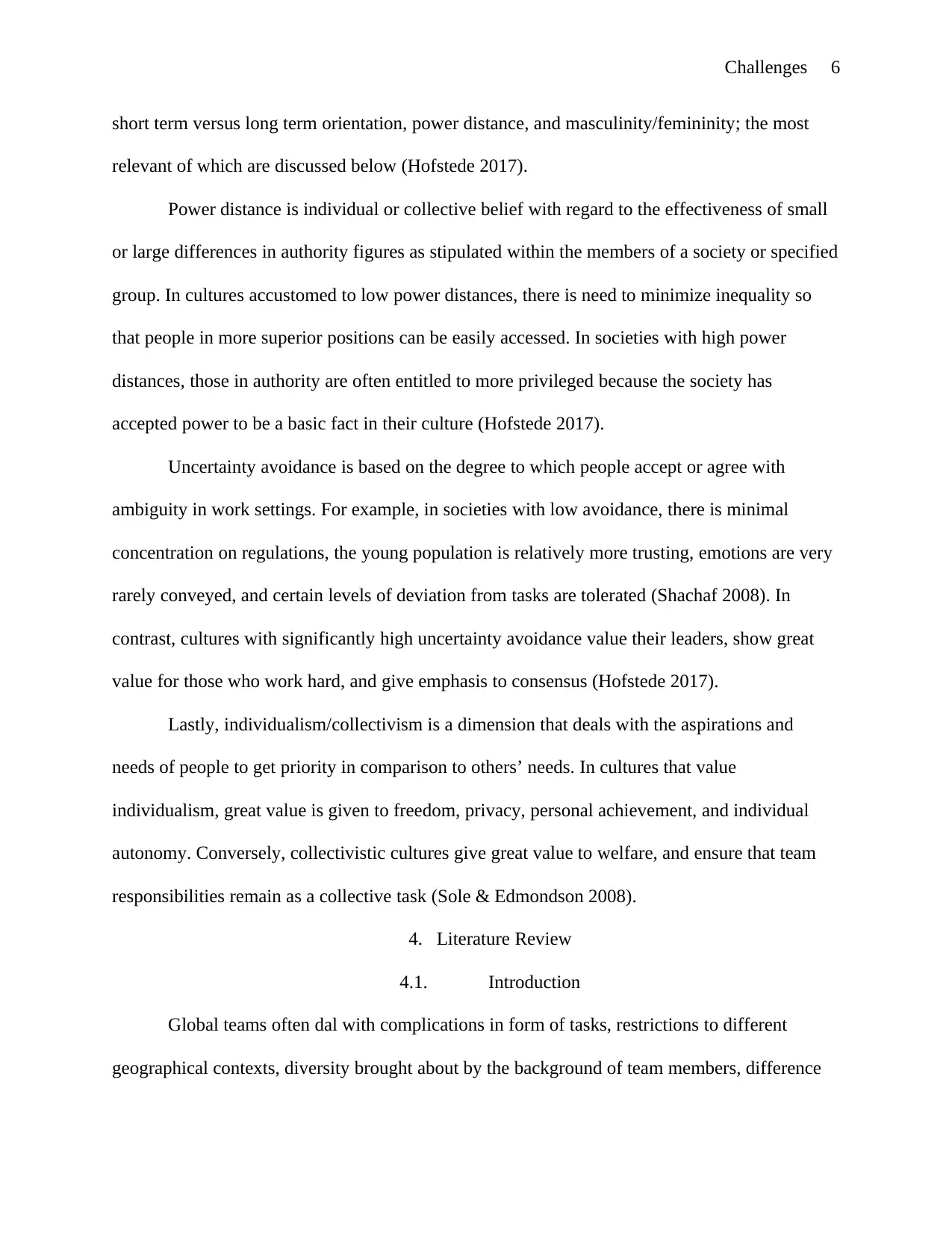
Challenges 6
short term versus long term orientation, power distance, and masculinity/femininity; the most
relevant of which are discussed below (Hofstede 2017).
Power distance is individual or collective belief with regard to the effectiveness of small
or large differences in authority figures as stipulated within the members of a society or specified
group. In cultures accustomed to low power distances, there is need to minimize inequality so
that people in more superior positions can be easily accessed. In societies with high power
distances, those in authority are often entitled to more privileged because the society has
accepted power to be a basic fact in their culture (Hofstede 2017).
Uncertainty avoidance is based on the degree to which people accept or agree with
ambiguity in work settings. For example, in societies with low avoidance, there is minimal
concentration on regulations, the young population is relatively more trusting, emotions are very
rarely conveyed, and certain levels of deviation from tasks are tolerated (Shachaf 2008). In
contrast, cultures with significantly high uncertainty avoidance value their leaders, show great
value for those who work hard, and give emphasis to consensus (Hofstede 2017).
Lastly, individualism/collectivism is a dimension that deals with the aspirations and
needs of people to get priority in comparison to others’ needs. In cultures that value
individualism, great value is given to freedom, privacy, personal achievement, and individual
autonomy. Conversely, collectivistic cultures give great value to welfare, and ensure that team
responsibilities remain as a collective task (Sole & Edmondson 2008).
4. Literature Review
4.1. Introduction
Global teams often dal with complications in form of tasks, restrictions to different
geographical contexts, diversity brought about by the background of team members, difference
short term versus long term orientation, power distance, and masculinity/femininity; the most
relevant of which are discussed below (Hofstede 2017).
Power distance is individual or collective belief with regard to the effectiveness of small
or large differences in authority figures as stipulated within the members of a society or specified
group. In cultures accustomed to low power distances, there is need to minimize inequality so
that people in more superior positions can be easily accessed. In societies with high power
distances, those in authority are often entitled to more privileged because the society has
accepted power to be a basic fact in their culture (Hofstede 2017).
Uncertainty avoidance is based on the degree to which people accept or agree with
ambiguity in work settings. For example, in societies with low avoidance, there is minimal
concentration on regulations, the young population is relatively more trusting, emotions are very
rarely conveyed, and certain levels of deviation from tasks are tolerated (Shachaf 2008). In
contrast, cultures with significantly high uncertainty avoidance value their leaders, show great
value for those who work hard, and give emphasis to consensus (Hofstede 2017).
Lastly, individualism/collectivism is a dimension that deals with the aspirations and
needs of people to get priority in comparison to others’ needs. In cultures that value
individualism, great value is given to freedom, privacy, personal achievement, and individual
autonomy. Conversely, collectivistic cultures give great value to welfare, and ensure that team
responsibilities remain as a collective task (Sole & Edmondson 2008).
4. Literature Review
4.1. Introduction
Global teams often dal with complications in form of tasks, restrictions to different
geographical contexts, diversity brought about by the background of team members, difference
⊘ This is a preview!⊘
Do you want full access?
Subscribe today to unlock all pages.

Trusted by 1+ million students worldwide
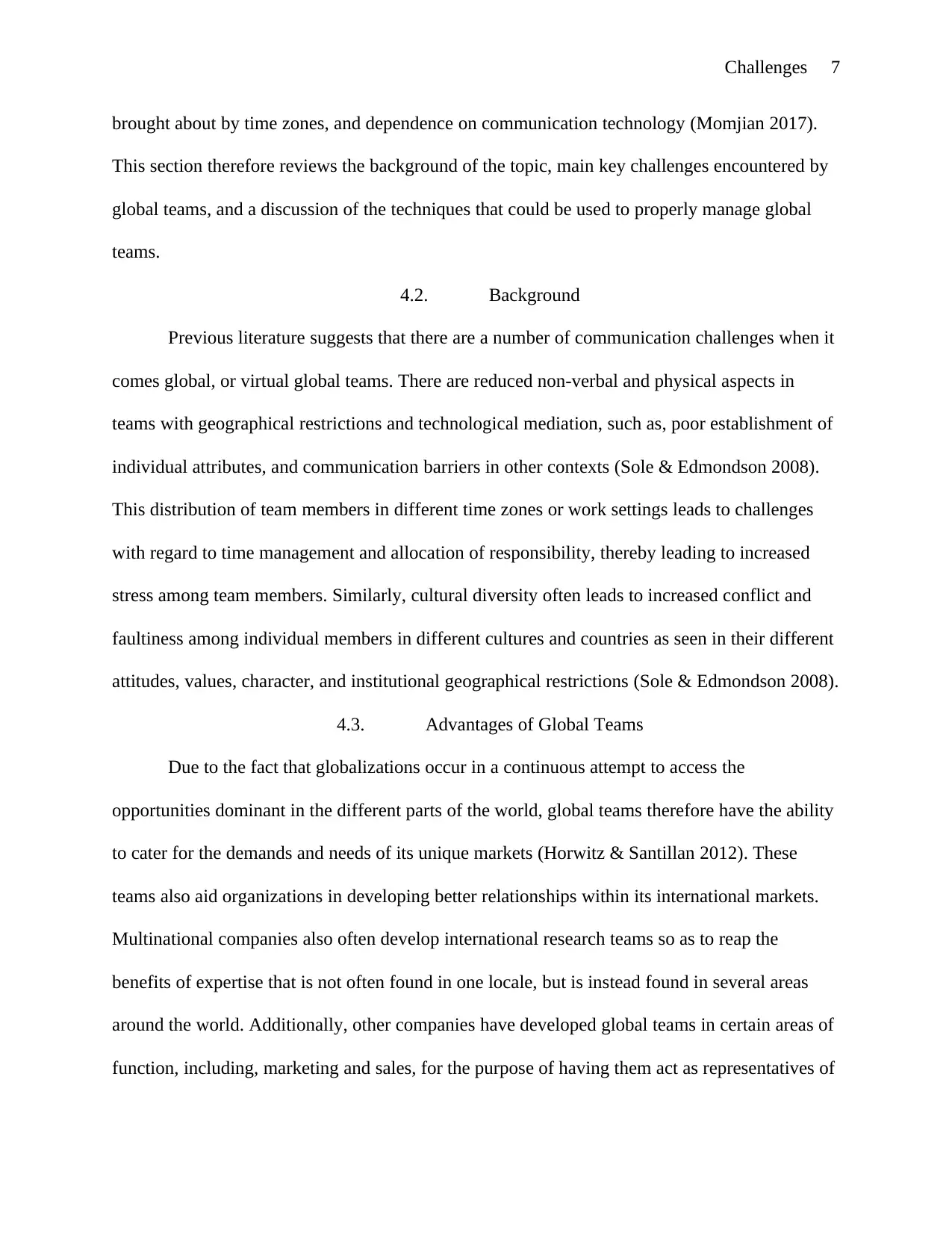
Challenges 7
brought about by time zones, and dependence on communication technology (Momjian 2017).
This section therefore reviews the background of the topic, main key challenges encountered by
global teams, and a discussion of the techniques that could be used to properly manage global
teams.
4.2. Background
Previous literature suggests that there are a number of communication challenges when it
comes global, or virtual global teams. There are reduced non-verbal and physical aspects in
teams with geographical restrictions and technological mediation, such as, poor establishment of
individual attributes, and communication barriers in other contexts (Sole & Edmondson 2008).
This distribution of team members in different time zones or work settings leads to challenges
with regard to time management and allocation of responsibility, thereby leading to increased
stress among team members. Similarly, cultural diversity often leads to increased conflict and
faultiness among individual members in different cultures and countries as seen in their different
attitudes, values, character, and institutional geographical restrictions (Sole & Edmondson 2008).
4.3. Advantages of Global Teams
Due to the fact that globalizations occur in a continuous attempt to access the
opportunities dominant in the different parts of the world, global teams therefore have the ability
to cater for the demands and needs of its unique markets (Horwitz & Santillan 2012). These
teams also aid organizations in developing better relationships within its international markets.
Multinational companies also often develop international research teams so as to reap the
benefits of expertise that is not often found in one locale, but is instead found in several areas
around the world. Additionally, other companies have developed global teams in certain areas of
function, including, marketing and sales, for the purpose of having them act as representatives of
brought about by time zones, and dependence on communication technology (Momjian 2017).
This section therefore reviews the background of the topic, main key challenges encountered by
global teams, and a discussion of the techniques that could be used to properly manage global
teams.
4.2. Background
Previous literature suggests that there are a number of communication challenges when it
comes global, or virtual global teams. There are reduced non-verbal and physical aspects in
teams with geographical restrictions and technological mediation, such as, poor establishment of
individual attributes, and communication barriers in other contexts (Sole & Edmondson 2008).
This distribution of team members in different time zones or work settings leads to challenges
with regard to time management and allocation of responsibility, thereby leading to increased
stress among team members. Similarly, cultural diversity often leads to increased conflict and
faultiness among individual members in different cultures and countries as seen in their different
attitudes, values, character, and institutional geographical restrictions (Sole & Edmondson 2008).
4.3. Advantages of Global Teams
Due to the fact that globalizations occur in a continuous attempt to access the
opportunities dominant in the different parts of the world, global teams therefore have the ability
to cater for the demands and needs of its unique markets (Horwitz & Santillan 2012). These
teams also aid organizations in developing better relationships within its international markets.
Multinational companies also often develop international research teams so as to reap the
benefits of expertise that is not often found in one locale, but is instead found in several areas
around the world. Additionally, other companies have developed global teams in certain areas of
function, including, marketing and sales, for the purpose of having them act as representatives of
Paraphrase This Document
Need a fresh take? Get an instant paraphrase of this document with our AI Paraphraser
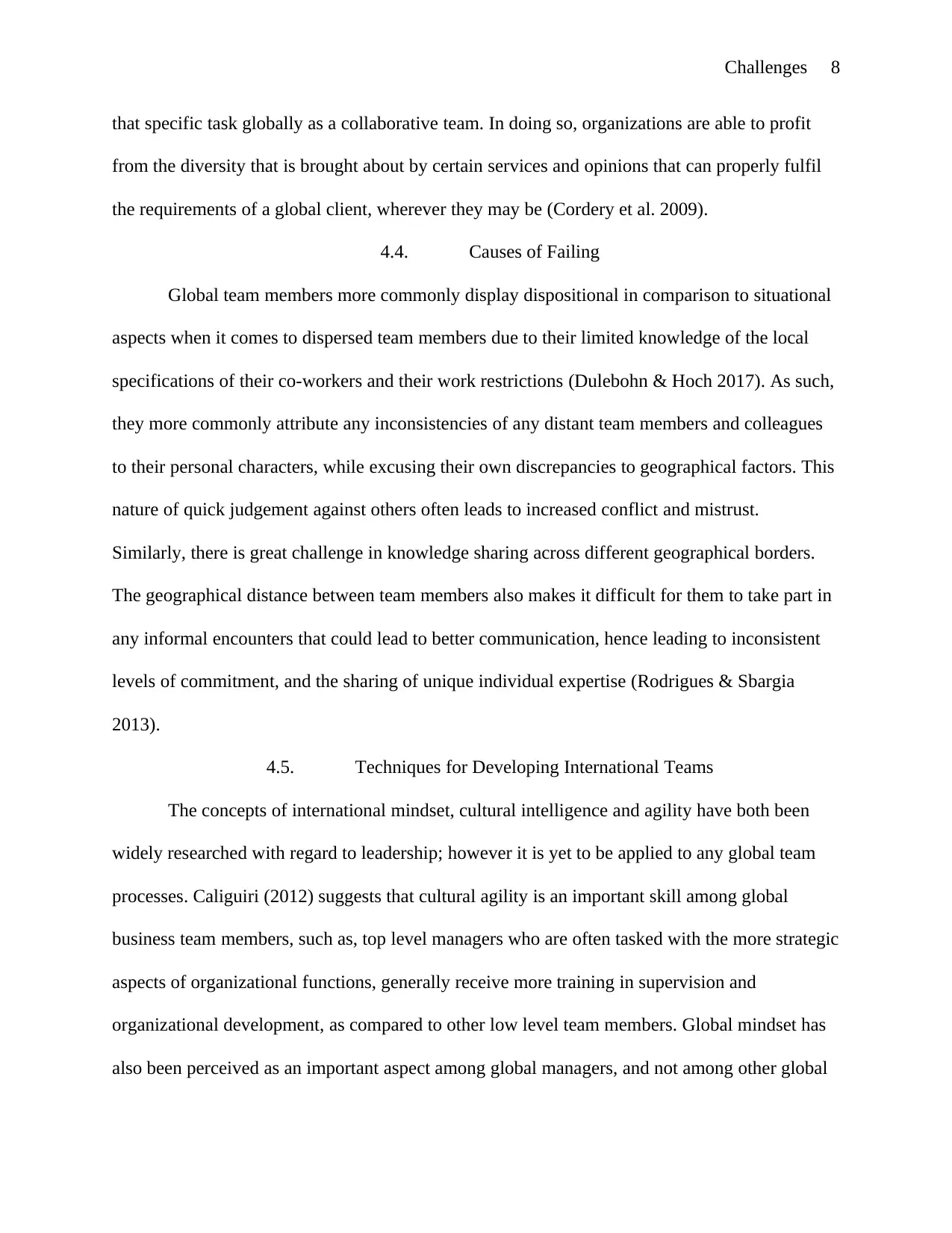
Challenges 8
that specific task globally as a collaborative team. In doing so, organizations are able to profit
from the diversity that is brought about by certain services and opinions that can properly fulfil
the requirements of a global client, wherever they may be (Cordery et al. 2009).
4.4. Causes of Failing
Global team members more commonly display dispositional in comparison to situational
aspects when it comes to dispersed team members due to their limited knowledge of the local
specifications of their co-workers and their work restrictions (Dulebohn & Hoch 2017). As such,
they more commonly attribute any inconsistencies of any distant team members and colleagues
to their personal characters, while excusing their own discrepancies to geographical factors. This
nature of quick judgement against others often leads to increased conflict and mistrust.
Similarly, there is great challenge in knowledge sharing across different geographical borders.
The geographical distance between team members also makes it difficult for them to take part in
any informal encounters that could lead to better communication, hence leading to inconsistent
levels of commitment, and the sharing of unique individual expertise (Rodrigues & Sbargia
2013).
4.5. Techniques for Developing International Teams
The concepts of international mindset, cultural intelligence and agility have both been
widely researched with regard to leadership; however it is yet to be applied to any global team
processes. Caliguiri (2012) suggests that cultural agility is an important skill among global
business team members, such as, top level managers who are often tasked with the more strategic
aspects of organizational functions, generally receive more training in supervision and
organizational development, as compared to other low level team members. Global mindset has
also been perceived as an important aspect among global managers, and not among other global
that specific task globally as a collaborative team. In doing so, organizations are able to profit
from the diversity that is brought about by certain services and opinions that can properly fulfil
the requirements of a global client, wherever they may be (Cordery et al. 2009).
4.4. Causes of Failing
Global team members more commonly display dispositional in comparison to situational
aspects when it comes to dispersed team members due to their limited knowledge of the local
specifications of their co-workers and their work restrictions (Dulebohn & Hoch 2017). As such,
they more commonly attribute any inconsistencies of any distant team members and colleagues
to their personal characters, while excusing their own discrepancies to geographical factors. This
nature of quick judgement against others often leads to increased conflict and mistrust.
Similarly, there is great challenge in knowledge sharing across different geographical borders.
The geographical distance between team members also makes it difficult for them to take part in
any informal encounters that could lead to better communication, hence leading to inconsistent
levels of commitment, and the sharing of unique individual expertise (Rodrigues & Sbargia
2013).
4.5. Techniques for Developing International Teams
The concepts of international mindset, cultural intelligence and agility have both been
widely researched with regard to leadership; however it is yet to be applied to any global team
processes. Caliguiri (2012) suggests that cultural agility is an important skill among global
business team members, such as, top level managers who are often tasked with the more strategic
aspects of organizational functions, generally receive more training in supervision and
organizational development, as compared to other low level team members. Global mindset has
also been perceived as an important aspect among global managers, and not among other global
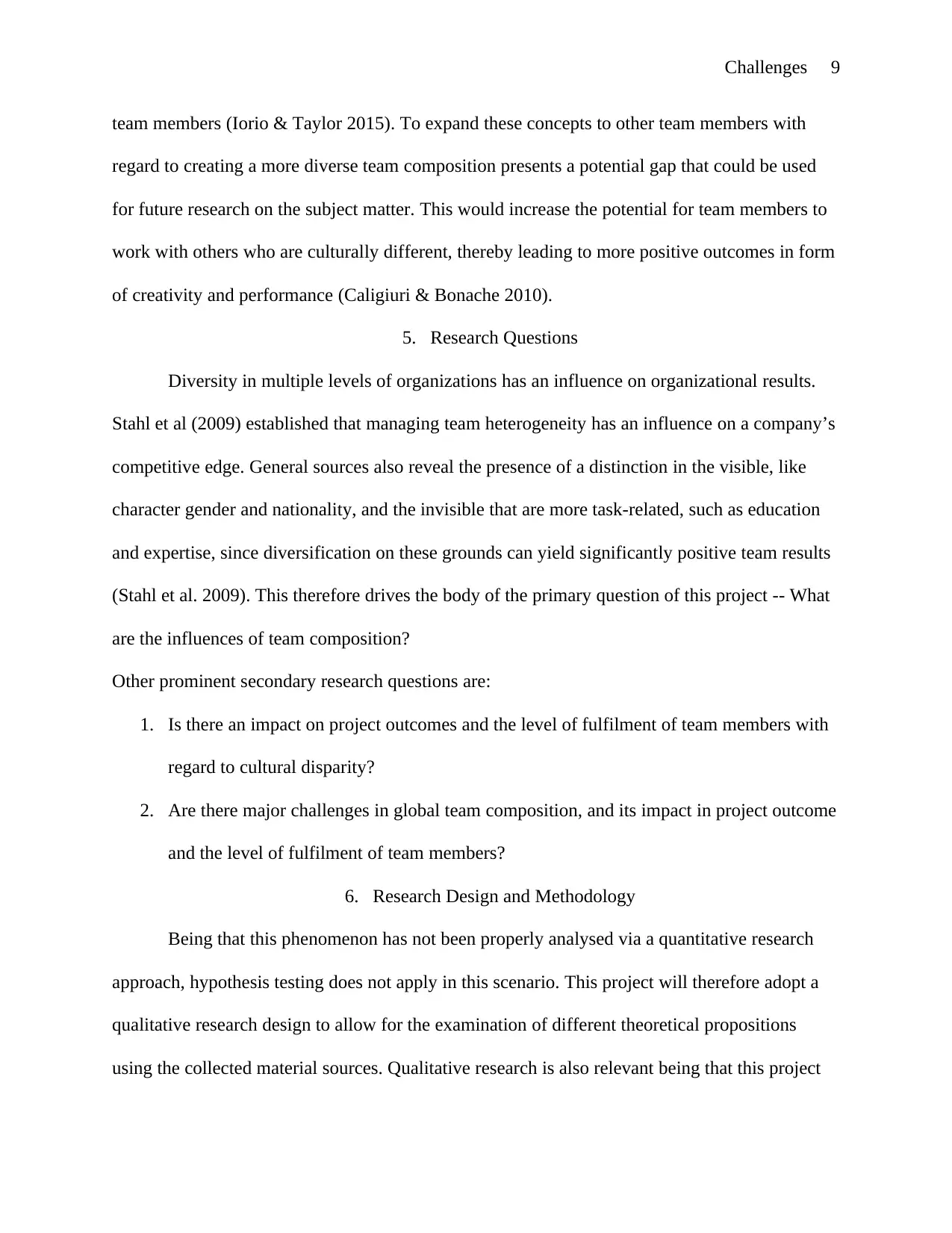
Challenges 9
team members (Iorio & Taylor 2015). To expand these concepts to other team members with
regard to creating a more diverse team composition presents a potential gap that could be used
for future research on the subject matter. This would increase the potential for team members to
work with others who are culturally different, thereby leading to more positive outcomes in form
of creativity and performance (Caligiuri & Bonache 2010).
5. Research Questions
Diversity in multiple levels of organizations has an influence on organizational results.
Stahl et al (2009) established that managing team heterogeneity has an influence on a company’s
competitive edge. General sources also reveal the presence of a distinction in the visible, like
character gender and nationality, and the invisible that are more task-related, such as education
and expertise, since diversification on these grounds can yield significantly positive team results
(Stahl et al. 2009). This therefore drives the body of the primary question of this project -- What
are the influences of team composition?
Other prominent secondary research questions are:
1. Is there an impact on project outcomes and the level of fulfilment of team members with
regard to cultural disparity?
2. Are there major challenges in global team composition, and its impact in project outcome
and the level of fulfilment of team members?
6. Research Design and Methodology
Being that this phenomenon has not been properly analysed via a quantitative research
approach, hypothesis testing does not apply in this scenario. This project will therefore adopt a
qualitative research design to allow for the examination of different theoretical propositions
using the collected material sources. Qualitative research is also relevant being that this project
team members (Iorio & Taylor 2015). To expand these concepts to other team members with
regard to creating a more diverse team composition presents a potential gap that could be used
for future research on the subject matter. This would increase the potential for team members to
work with others who are culturally different, thereby leading to more positive outcomes in form
of creativity and performance (Caligiuri & Bonache 2010).
5. Research Questions
Diversity in multiple levels of organizations has an influence on organizational results.
Stahl et al (2009) established that managing team heterogeneity has an influence on a company’s
competitive edge. General sources also reveal the presence of a distinction in the visible, like
character gender and nationality, and the invisible that are more task-related, such as education
and expertise, since diversification on these grounds can yield significantly positive team results
(Stahl et al. 2009). This therefore drives the body of the primary question of this project -- What
are the influences of team composition?
Other prominent secondary research questions are:
1. Is there an impact on project outcomes and the level of fulfilment of team members with
regard to cultural disparity?
2. Are there major challenges in global team composition, and its impact in project outcome
and the level of fulfilment of team members?
6. Research Design and Methodology
Being that this phenomenon has not been properly analysed via a quantitative research
approach, hypothesis testing does not apply in this scenario. This project will therefore adopt a
qualitative research design to allow for the examination of different theoretical propositions
using the collected material sources. Qualitative research is also relevant being that this project
⊘ This is a preview!⊘
Do you want full access?
Subscribe today to unlock all pages.

Trusted by 1+ million students worldwide
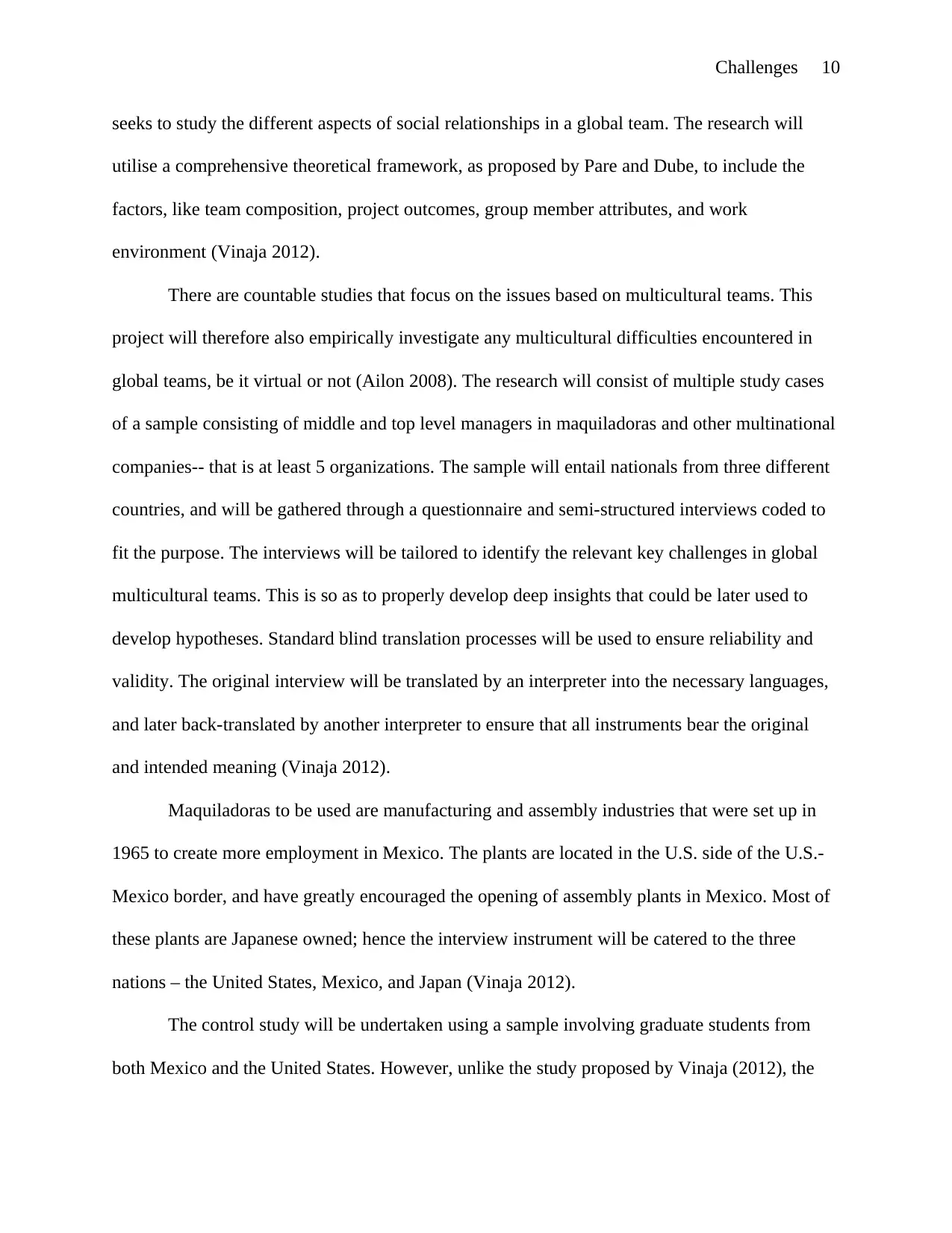
Challenges 10
seeks to study the different aspects of social relationships in a global team. The research will
utilise a comprehensive theoretical framework, as proposed by Pare and Dube, to include the
factors, like team composition, project outcomes, group member attributes, and work
environment (Vinaja 2012).
There are countable studies that focus on the issues based on multicultural teams. This
project will therefore also empirically investigate any multicultural difficulties encountered in
global teams, be it virtual or not (Ailon 2008). The research will consist of multiple study cases
of a sample consisting of middle and top level managers in maquiladoras and other multinational
companies-- that is at least 5 organizations. The sample will entail nationals from three different
countries, and will be gathered through a questionnaire and semi-structured interviews coded to
fit the purpose. The interviews will be tailored to identify the relevant key challenges in global
multicultural teams. This is so as to properly develop deep insights that could be later used to
develop hypotheses. Standard blind translation processes will be used to ensure reliability and
validity. The original interview will be translated by an interpreter into the necessary languages,
and later back-translated by another interpreter to ensure that all instruments bear the original
and intended meaning (Vinaja 2012).
Maquiladoras to be used are manufacturing and assembly industries that were set up in
1965 to create more employment in Mexico. The plants are located in the U.S. side of the U.S.-
Mexico border, and have greatly encouraged the opening of assembly plants in Mexico. Most of
these plants are Japanese owned; hence the interview instrument will be catered to the three
nations – the United States, Mexico, and Japan (Vinaja 2012).
The control study will be undertaken using a sample involving graduate students from
both Mexico and the United States. However, unlike the study proposed by Vinaja (2012), the
seeks to study the different aspects of social relationships in a global team. The research will
utilise a comprehensive theoretical framework, as proposed by Pare and Dube, to include the
factors, like team composition, project outcomes, group member attributes, and work
environment (Vinaja 2012).
There are countable studies that focus on the issues based on multicultural teams. This
project will therefore also empirically investigate any multicultural difficulties encountered in
global teams, be it virtual or not (Ailon 2008). The research will consist of multiple study cases
of a sample consisting of middle and top level managers in maquiladoras and other multinational
companies-- that is at least 5 organizations. The sample will entail nationals from three different
countries, and will be gathered through a questionnaire and semi-structured interviews coded to
fit the purpose. The interviews will be tailored to identify the relevant key challenges in global
multicultural teams. This is so as to properly develop deep insights that could be later used to
develop hypotheses. Standard blind translation processes will be used to ensure reliability and
validity. The original interview will be translated by an interpreter into the necessary languages,
and later back-translated by another interpreter to ensure that all instruments bear the original
and intended meaning (Vinaja 2012).
Maquiladoras to be used are manufacturing and assembly industries that were set up in
1965 to create more employment in Mexico. The plants are located in the U.S. side of the U.S.-
Mexico border, and have greatly encouraged the opening of assembly plants in Mexico. Most of
these plants are Japanese owned; hence the interview instrument will be catered to the three
nations – the United States, Mexico, and Japan (Vinaja 2012).
The control study will be undertaken using a sample involving graduate students from
both Mexico and the United States. However, unlike the study proposed by Vinaja (2012), the
Paraphrase This Document
Need a fresh take? Get an instant paraphrase of this document with our AI Paraphraser
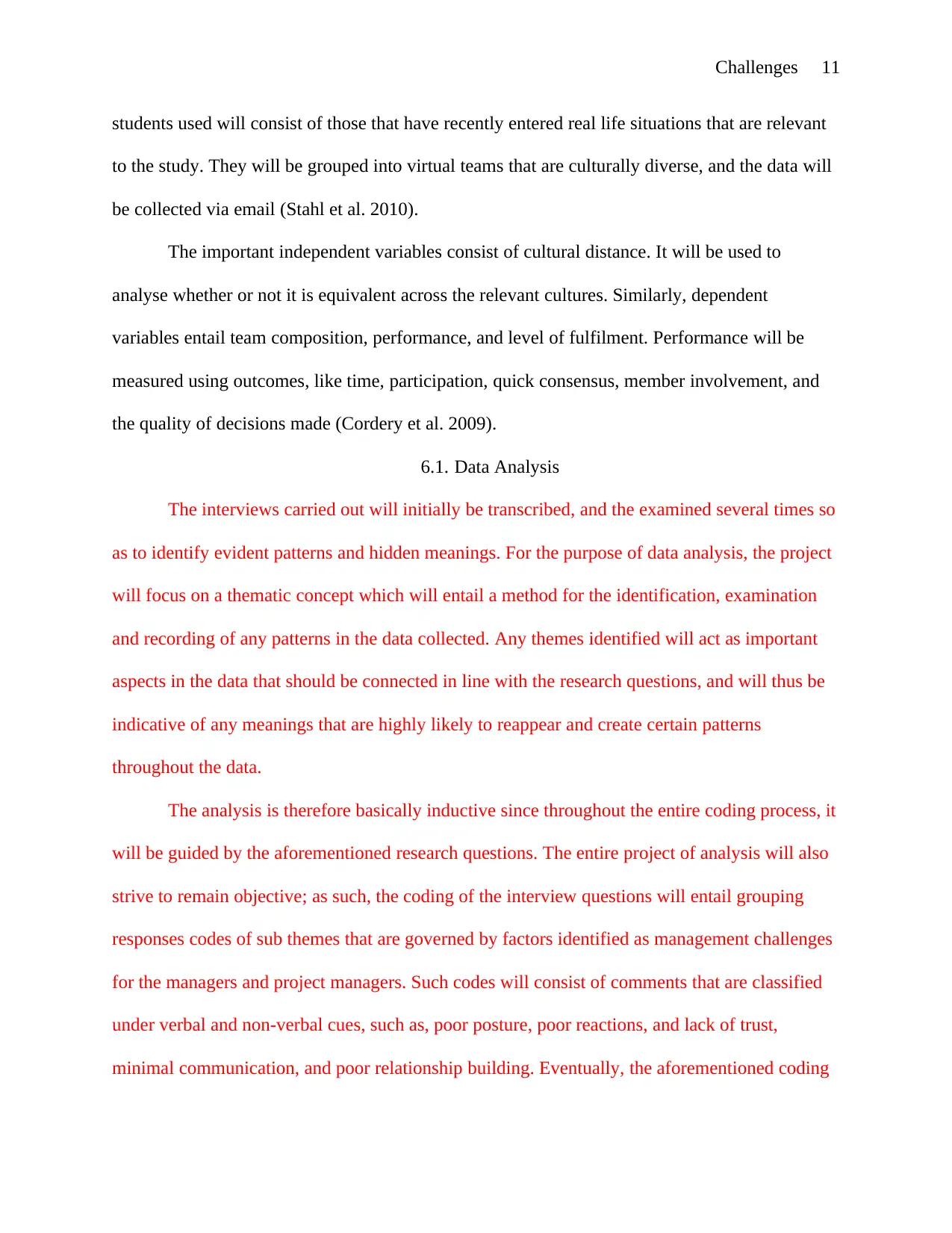
Challenges 11
students used will consist of those that have recently entered real life situations that are relevant
to the study. They will be grouped into virtual teams that are culturally diverse, and the data will
be collected via email (Stahl et al. 2010).
The important independent variables consist of cultural distance. It will be used to
analyse whether or not it is equivalent across the relevant cultures. Similarly, dependent
variables entail team composition, performance, and level of fulfilment. Performance will be
measured using outcomes, like time, participation, quick consensus, member involvement, and
the quality of decisions made (Cordery et al. 2009).
6.1. Data Analysis
The interviews carried out will initially be transcribed, and the examined several times so
as to identify evident patterns and hidden meanings. For the purpose of data analysis, the project
will focus on a thematic concept which will entail a method for the identification, examination
and recording of any patterns in the data collected. Any themes identified will act as important
aspects in the data that should be connected in line with the research questions, and will thus be
indicative of any meanings that are highly likely to reappear and create certain patterns
throughout the data.
The analysis is therefore basically inductive since throughout the entire coding process, it
will be guided by the aforementioned research questions. The entire project of analysis will also
strive to remain objective; as such, the coding of the interview questions will entail grouping
responses codes of sub themes that are governed by factors identified as management challenges
for the managers and project managers. Such codes will consist of comments that are classified
under verbal and non-verbal cues, such as, poor posture, poor reactions, and lack of trust,
minimal communication, and poor relationship building. Eventually, the aforementioned coding
students used will consist of those that have recently entered real life situations that are relevant
to the study. They will be grouped into virtual teams that are culturally diverse, and the data will
be collected via email (Stahl et al. 2010).
The important independent variables consist of cultural distance. It will be used to
analyse whether or not it is equivalent across the relevant cultures. Similarly, dependent
variables entail team composition, performance, and level of fulfilment. Performance will be
measured using outcomes, like time, participation, quick consensus, member involvement, and
the quality of decisions made (Cordery et al. 2009).
6.1. Data Analysis
The interviews carried out will initially be transcribed, and the examined several times so
as to identify evident patterns and hidden meanings. For the purpose of data analysis, the project
will focus on a thematic concept which will entail a method for the identification, examination
and recording of any patterns in the data collected. Any themes identified will act as important
aspects in the data that should be connected in line with the research questions, and will thus be
indicative of any meanings that are highly likely to reappear and create certain patterns
throughout the data.
The analysis is therefore basically inductive since throughout the entire coding process, it
will be guided by the aforementioned research questions. The entire project of analysis will also
strive to remain objective; as such, the coding of the interview questions will entail grouping
responses codes of sub themes that are governed by factors identified as management challenges
for the managers and project managers. Such codes will consist of comments that are classified
under verbal and non-verbal cues, such as, poor posture, poor reactions, and lack of trust,
minimal communication, and poor relationship building. Eventually, the aforementioned coding
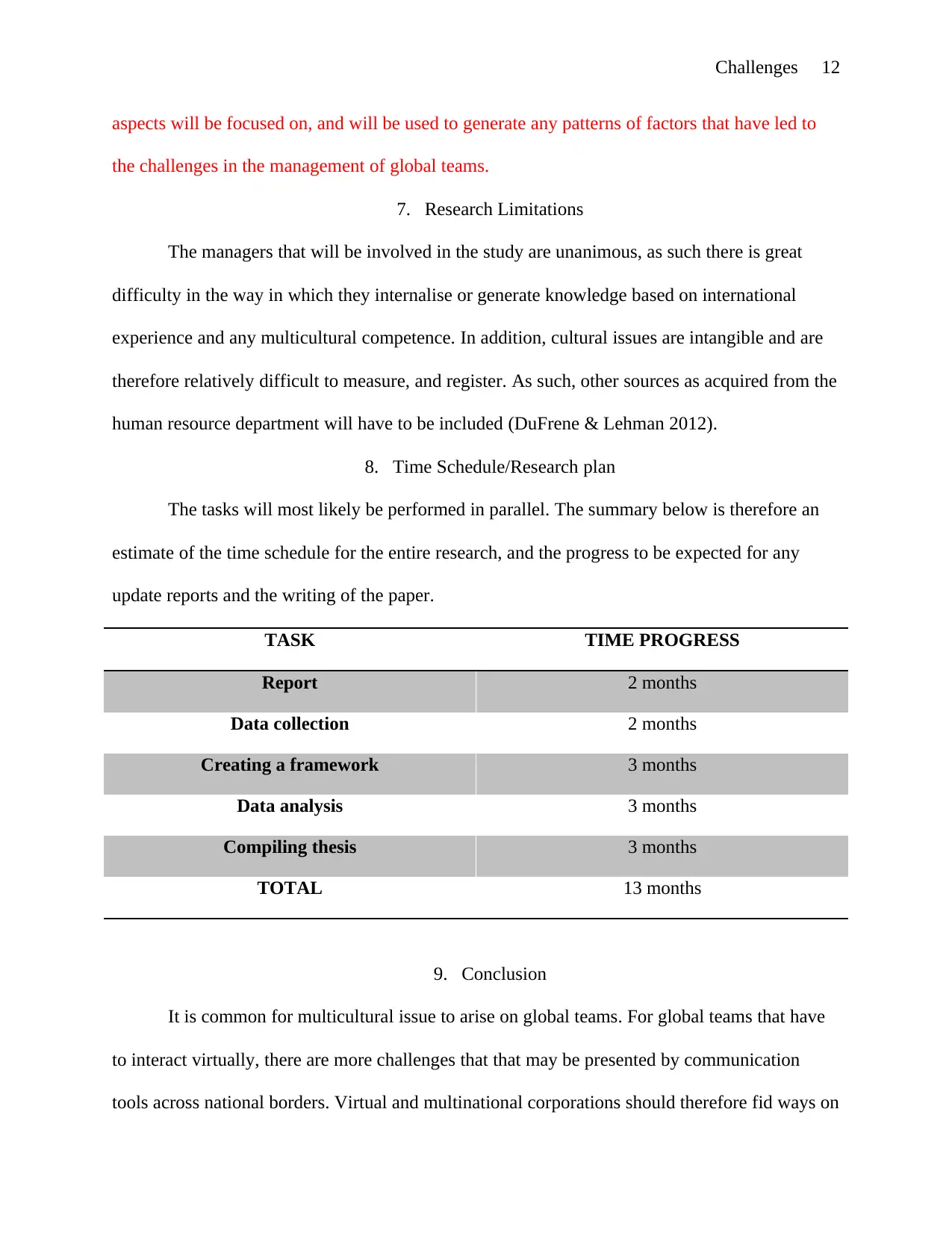
Challenges 12
aspects will be focused on, and will be used to generate any patterns of factors that have led to
the challenges in the management of global teams.
7. Research Limitations
The managers that will be involved in the study are unanimous, as such there is great
difficulty in the way in which they internalise or generate knowledge based on international
experience and any multicultural competence. In addition, cultural issues are intangible and are
therefore relatively difficult to measure, and register. As such, other sources as acquired from the
human resource department will have to be included (DuFrene & Lehman 2012).
8. Time Schedule/Research plan
The tasks will most likely be performed in parallel. The summary below is therefore an
estimate of the time schedule for the entire research, and the progress to be expected for any
update reports and the writing of the paper.
TASK TIME PROGRESS
Report 2 months
Data collection 2 months
Creating a framework 3 months
Data analysis 3 months
Compiling thesis 3 months
TOTAL 13 months
9. Conclusion
It is common for multicultural issue to arise on global teams. For global teams that have
to interact virtually, there are more challenges that that may be presented by communication
tools across national borders. Virtual and multinational corporations should therefore fid ways on
aspects will be focused on, and will be used to generate any patterns of factors that have led to
the challenges in the management of global teams.
7. Research Limitations
The managers that will be involved in the study are unanimous, as such there is great
difficulty in the way in which they internalise or generate knowledge based on international
experience and any multicultural competence. In addition, cultural issues are intangible and are
therefore relatively difficult to measure, and register. As such, other sources as acquired from the
human resource department will have to be included (DuFrene & Lehman 2012).
8. Time Schedule/Research plan
The tasks will most likely be performed in parallel. The summary below is therefore an
estimate of the time schedule for the entire research, and the progress to be expected for any
update reports and the writing of the paper.
TASK TIME PROGRESS
Report 2 months
Data collection 2 months
Creating a framework 3 months
Data analysis 3 months
Compiling thesis 3 months
TOTAL 13 months
9. Conclusion
It is common for multicultural issue to arise on global teams. For global teams that have
to interact virtually, there are more challenges that that may be presented by communication
tools across national borders. Virtual and multinational corporations should therefore fid ways on
⊘ This is a preview!⊘
Do you want full access?
Subscribe today to unlock all pages.

Trusted by 1+ million students worldwide
1 out of 16
Related Documents
Your All-in-One AI-Powered Toolkit for Academic Success.
+13062052269
info@desklib.com
Available 24*7 on WhatsApp / Email
![[object Object]](/_next/static/media/star-bottom.7253800d.svg)
Unlock your academic potential
Copyright © 2020–2025 A2Z Services. All Rights Reserved. Developed and managed by ZUCOL.





